Departing from Kabupaten Asahan, we entered Kabupaten Tapanuli Utara, a region where Batak Toba people originally came from. This region is situated at the centre of the Province of North Sumatra and contains many small “kampung” (huta) which, some of them, were named after the Bataknese family names who resides in the areas. I bring up the term “Batak Toba” to introduce the fact that there are actually several sub-tribes of Batak such as Toba, Karo, Pakpak, Simalungun, and Mandailing; each has slightly different family names, culture and language.
We started at Porsea, where my mother’s homeland was. It is sometimes confusing when we use the term “homeland” as Batak people mostly tend to migrate. One can say that Porsea is the homeland of the Manurung’s descendants but it does not necessarily mean that the Manurungs had never been elsewhere before. And in addition, it does not, in any way, mean that an area only belongs to one family as many others also resided there. Sitorus, Sirait, and Butar-butar also resides here.
We visited the tomb of my grandfather’s parents from my mother’s side. Our next destination was Balige, we’re heading there simply to check out the tomb of Sisingamangaraja XII. I later found out that Balige is, of course together with several other families, the homeland of Siahaan’s descendants.
Sisingamangaraja XII
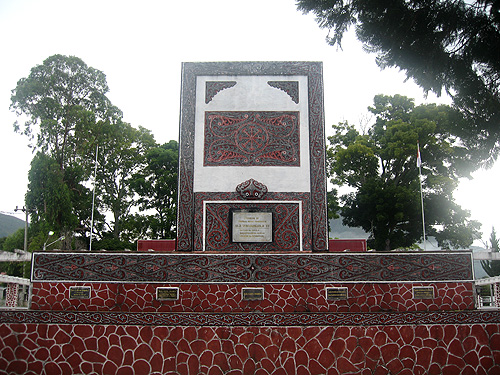 He is regarded as one of the national heroes of Indonesia for his struggle confronting the Dutch invasion to Tapanuli. Legends say that he had some supernatural resistance to fire bullets and by which he could not ever be killed but solely on condition that his hands shall never be desecrated by human blood. The Dutch troops finally revealed his secret and shot his beloved daughter. As expected, he was so devastated by sorrow and sadness that he could not resist to not hug his dear dead covered-with-blood daughter. He was then shot to death by a bullet of the Dutch armies.
He is regarded as one of the national heroes of Indonesia for his struggle confronting the Dutch invasion to Tapanuli. Legends say that he had some supernatural resistance to fire bullets and by which he could not ever be killed but solely on condition that his hands shall never be desecrated by human blood. The Dutch troops finally revealed his secret and shot his beloved daughter. As expected, he was so devastated by sorrow and sadness that he could not resist to not hug his dear dead covered-with-blood daughter. He was then shot to death by a bullet of the Dutch armies.
Afterwards, we headed to Tarutung, the capital district of Kabupaten Tapanuli Utara. Tarutung is the homeland of Hutagalung’s descendants. Tobing, Hutapea, Hutauruk, and Simorangkir also resides here. We visited another tomb in Tarutung, it was the tomb of my grandfather’s parents (and grandparents) from my father’s side. The tombs is situated at the hillside of a mountain, so high we have to walk so far to arrive there (and we ended up having sore feet). Hahaha.
Dr. I. L. Nommensen
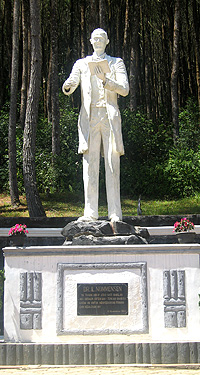 We then visited Salib Kasih, a natural complex built to commemorate the arrival of Nommensen at Tapanuli. Nommensen was a German Christian missionary who came in the. He arrived at Barus and continued his religious mission to Tarutung. Apparently, he was not the first missionary who came for Bataknese people; he was the third, stories say. But none of his predecessors succeeded their mission and in fact they were killed and eaten (legends say).
We then visited Salib Kasih, a natural complex built to commemorate the arrival of Nommensen at Tapanuli. Nommensen was a German Christian missionary who came in the. He arrived at Barus and continued his religious mission to Tarutung. Apparently, he was not the first missionary who came for Bataknese people; he was the third, stories say. But none of his predecessors succeeded their mission and in fact they were killed and eaten (legends say).
Most Bataknese people residing in Tapanuli Utara and Tapanuli Tengah finally converted to Christian from their old tribal religion, Parmalim. Several Bataknese families who resided near Aceh and Padang (northern and southern areas of the Province) converted to Islam, instead.
Everyone is our family and we keep our numbers
As the consequence of keeping our family names, we can always track down our relatives and any inter-relation between several Bataknese families. At least at some point, two people sharing the same family name are of course related to each other (although it will take hours to reveal the links, we love doing this). And even if two people do not share the same family name, one will come up saying that one of his relative does share the same family name and that makes the two person simply a family. This will make one Bataknese person has many ‘additional’ uncles, aunties, siblings, nieces, nephews, and even grandparents. This is practically useful when we’re abroad and have no relative at all. Go search one Bataknese person and we will have one.
In addition to family names, we also have numbers that signify our position in the family tree. For instance, my father is Hutagalung number 14 while I’m Hutagalung number 15. That means my father is the 14th descendant of Raja Hutagalung and I’m the the 15th. My children will be the 16th and my grandchildren will be the 17th. This is essentially useful to find out what we should call somebody sharing the same family name with us if we could not find any direct or indirect familial relation. In many cases, we could.
That’s all for the day. The next day we are going to visit Prapat, Toba Lake, and Samosir Island. I did not expect to know this much about my ancestors and I’m so glad to get the chance to visit my homeland.
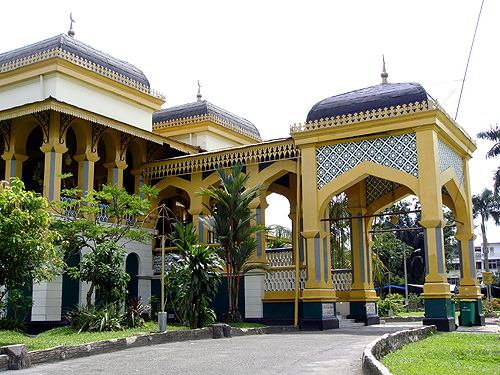

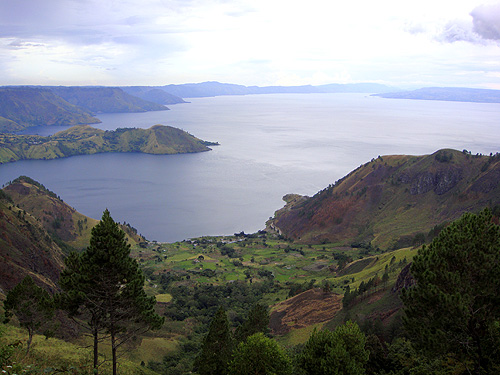 Lake Toba is a lake and supervolcano, 100 kilometres long and 30 kilometres wide, and 505 metres (1,666 ft) at its deepest point. Located in the middle of the northern part of the Indonesian island of Sumatra with a surface elevation of about 900 metres (2,953 ft), it is the largest volcanic lake in the world. In addition, it is the site of a supervolcanic eruption that occurred 74,000 years ago, a massive climate-changing event.
Lake Toba is a lake and supervolcano, 100 kilometres long and 30 kilometres wide, and 505 metres (1,666 ft) at its deepest point. Located in the middle of the northern part of the Indonesian island of Sumatra with a surface elevation of about 900 metres (2,953 ft), it is the largest volcanic lake in the world. In addition, it is the site of a supervolcanic eruption that occurred 74,000 years ago, a massive climate-changing event.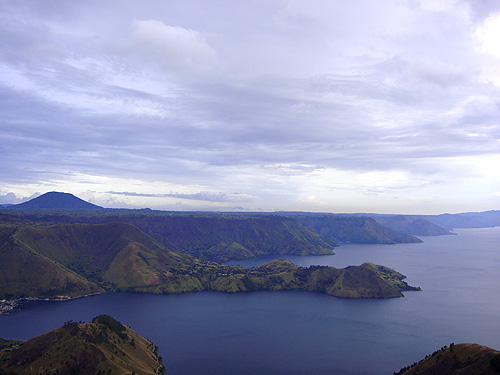

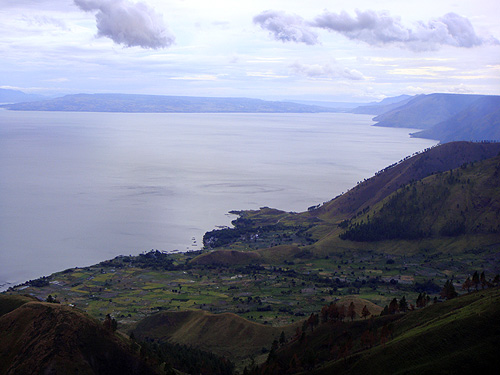
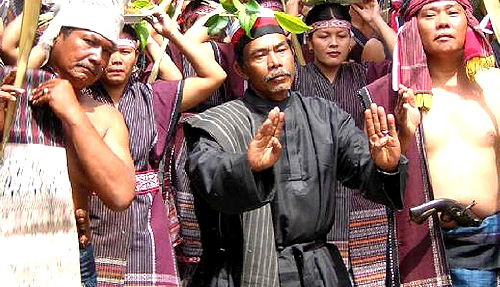 There was nothing essential this day, it’s another half-day in Prapat, a quarter-day in Pematang Siantar, and a night at Berastagi doing nearly nothing. We spent most of our time on the road laughing and screaming to make ourselves happy while crossing the borders which happened to be so lenghty and exhausting. The infrastructure was terrible and unmaintained but we had no choice. Thus, since I have been lately situated at the region concerned and have heard several opinions about this “Province of Tapanuli” issue, I guess it’s the time for me to write something about it.
There was nothing essential this day, it’s another half-day in Prapat, a quarter-day in Pematang Siantar, and a night at Berastagi doing nearly nothing. We spent most of our time on the road laughing and screaming to make ourselves happy while crossing the borders which happened to be so lenghty and exhausting. The infrastructure was terrible and unmaintained but we had no choice. Thus, since I have been lately situated at the region concerned and have heard several opinions about this “Province of Tapanuli” issue, I guess it’s the time for me to write something about it.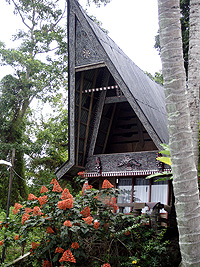 First of all, I want to say that I have made myself a record! How on earth can I have one blog post each day? Hahaha. I guess this was due to the fact that I had nothing to do but to eat and sleep during my abundant free time. On the other hand, I just could not help seeing my laptop intolerably unoccupied thus blogging was what I did. Anyway, this day is the fourth day of our trip and we’re finally done visiting tombs. I was glad to be able to visit my ancestors, get some insights about my family heritage, and learn the complicated family tree. From this moment on, it will be solely a holiday trip.
First of all, I want to say that I have made myself a record! How on earth can I have one blog post each day? Hahaha. I guess this was due to the fact that I had nothing to do but to eat and sleep during my abundant free time. On the other hand, I just could not help seeing my laptop intolerably unoccupied thus blogging was what I did. Anyway, this day is the fourth day of our trip and we’re finally done visiting tombs. I was glad to be able to visit my ancestors, get some insights about my family heritage, and learn the complicated family tree. From this moment on, it will be solely a holiday trip.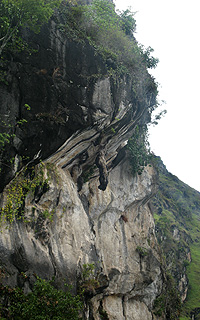 Before getting to the shore of the island, we stopped at Batu Gantung. It was nothing flashy but just an oddly-shaped rock hanging on a high cliff located at the side of the Lake. Legends say that there was a beautiful young lady from the Sinaga family who was forced to marry a prince. She disagreed and ran away from her house. Unfortunately, she did not realise that she were running on the top of the cliff and heading towards the Lake Toba just below. Just before the edge, she tripped with her feet stuck between roots, died in a very odd position, and turned into rocks. I spent minutes to imagine how this hanging rock could, in any way, look like a lady with her body turned upside-down.
Before getting to the shore of the island, we stopped at Batu Gantung. It was nothing flashy but just an oddly-shaped rock hanging on a high cliff located at the side of the Lake. Legends say that there was a beautiful young lady from the Sinaga family who was forced to marry a prince. She disagreed and ran away from her house. Unfortunately, she did not realise that she were running on the top of the cliff and heading towards the Lake Toba just below. Just before the edge, she tripped with her feet stuck between roots, died in a very odd position, and turned into rocks. I spent minutes to imagine how this hanging rock could, in any way, look like a lady with her body turned upside-down.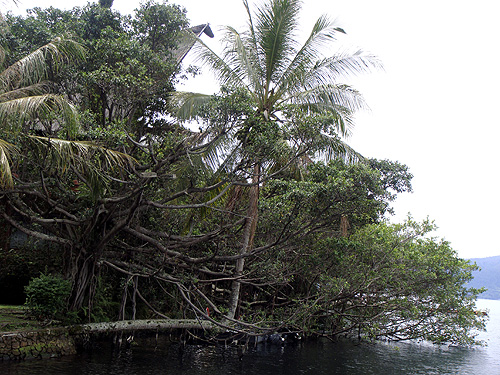 Do you see the oddness? This is a perfectly-edged coconut tree. I could not imagine how this coconut tree grew. How do you think it grew? I guess this tree did not naturally grow like that and I don’t look forward to hearing any “stories” behind this. Hehehe.
Do you see the oddness? This is a perfectly-edged coconut tree. I could not imagine how this coconut tree grew. How do you think it grew? I guess this tree did not naturally grow like that and I don’t look forward to hearing any “stories” behind this. Hehehe.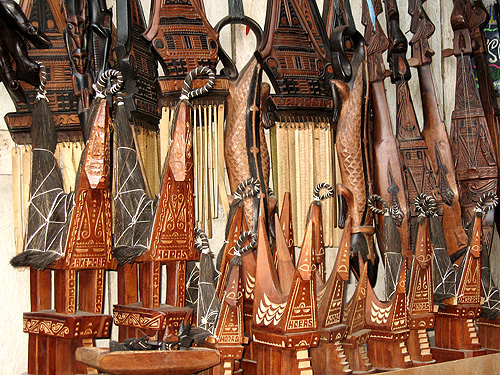 We ended our trip by going to Tomok, a region that used to be covered by water prior to the arrival of the Dutch armies. For your information, the Dutch drained the water to Sungai Asahan for power generation purposes. Tomok is also one of the popular spots for both local and international tourists coming to Lake Toba and Samosir Island. Above are a picture of some souvenirs sold in the souvenir shop. The picture, at the background, shows Bataknese calendar written in Bataknese numbers and at front, miniatures of Bataknese traditional houses.
We ended our trip by going to Tomok, a region that used to be covered by water prior to the arrival of the Dutch armies. For your information, the Dutch drained the water to Sungai Asahan for power generation purposes. Tomok is also one of the popular spots for both local and international tourists coming to Lake Toba and Samosir Island. Above are a picture of some souvenirs sold in the souvenir shop. The picture, at the background, shows Bataknese calendar written in Bataknese numbers and at front, miniatures of Bataknese traditional houses.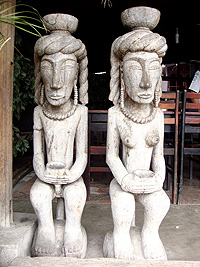
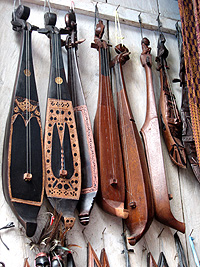
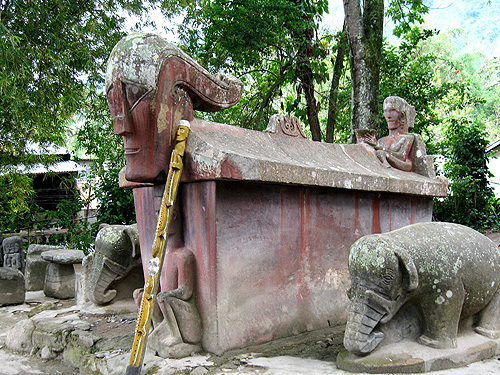 Stories say something about the king, his loyal queen, and his loyal general. The general was famous for his war epic and for his journey from Aceh to Samosir riding elephants. Legends also mention some background story about gecko (cicak) being the tribe’s symbolic animal and about reasons why Bataknese cultural products are often coloured with red, black, and white. Below is a picture of some statues doing the traditional ritual asking for rain. The real ritual is still conducted to date but is forbidden to be seen by visitors.
Stories say something about the king, his loyal queen, and his loyal general. The general was famous for his war epic and for his journey from Aceh to Samosir riding elephants. Legends also mention some background story about gecko (cicak) being the tribe’s symbolic animal and about reasons why Bataknese cultural products are often coloured with red, black, and white. Below is a picture of some statues doing the traditional ritual asking for rain. The real ritual is still conducted to date but is forbidden to be seen by visitors.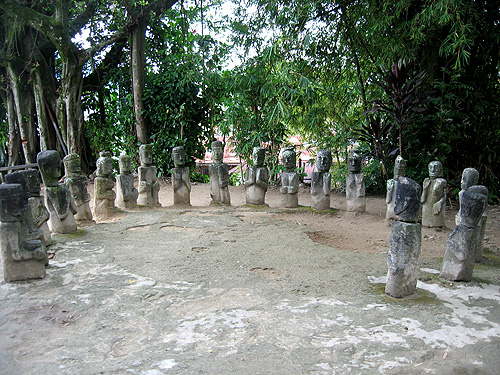 That’s all for the day. It will be Berastagi and Siantar for the next 2 days and Medan will finally be the ending point of this homeland journey. Anyway, I’ve just realised that I love taking pictures (of any objects, including of myself although I don’t put any here). I guess this is a sign that I’m about to have a new “toy”. Hahaha.
That’s all for the day. It will be Berastagi and Siantar for the next 2 days and Medan will finally be the ending point of this homeland journey. Anyway, I’ve just realised that I love taking pictures (of any objects, including of myself although I don’t put any here). I guess this is a sign that I’m about to have a new “toy”. Hahaha. He is regarded as one of the national heroes of Indonesia for his struggle confronting the Dutch invasion to Tapanuli. Legends say that he had some supernatural resistance to fire bullets and by which he could not ever be killed but solely on condition that his hands shall never be desecrated by human blood. The Dutch troops finally revealed his secret and shot his beloved daughter. As expected, he was so devastated by sorrow and sadness that he could not resist to not hug his dear dead covered-with-blood daughter. He was then shot to death by a bullet of the Dutch armies.
He is regarded as one of the national heroes of Indonesia for his struggle confronting the Dutch invasion to Tapanuli. Legends say that he had some supernatural resistance to fire bullets and by which he could not ever be killed but solely on condition that his hands shall never be desecrated by human blood. The Dutch troops finally revealed his secret and shot his beloved daughter. As expected, he was so devastated by sorrow and sadness that he could not resist to not hug his dear dead covered-with-blood daughter. He was then shot to death by a bullet of the Dutch armies. We then visited Salib Kasih, a natural complex built to commemorate the arrival of Nommensen at Tapanuli. Nommensen was a German Christian missionary who came in the. He arrived at Barus and continued his religious mission to Tarutung. Apparently, he was not the first missionary who came for Bataknese people; he was the third, stories say. But none of his predecessors succeeded their mission and in fact they were killed and eaten (legends say).
We then visited Salib Kasih, a natural complex built to commemorate the arrival of Nommensen at Tapanuli. Nommensen was a German Christian missionary who came in the. He arrived at Barus and continued his religious mission to Tarutung. Apparently, he was not the first missionary who came for Bataknese people; he was the third, stories say. But none of his predecessors succeeded their mission and in fact they were killed and eaten (legends say).